PEUGEOT 5008 2012 Owners Manual
Manufacturer: PEUGEOT, Model Year: 2012, Model line: 5008, Model: PEUGEOT 5008 2012Pages: 340, PDF Size: 16.42 MB
Page 191 of 340
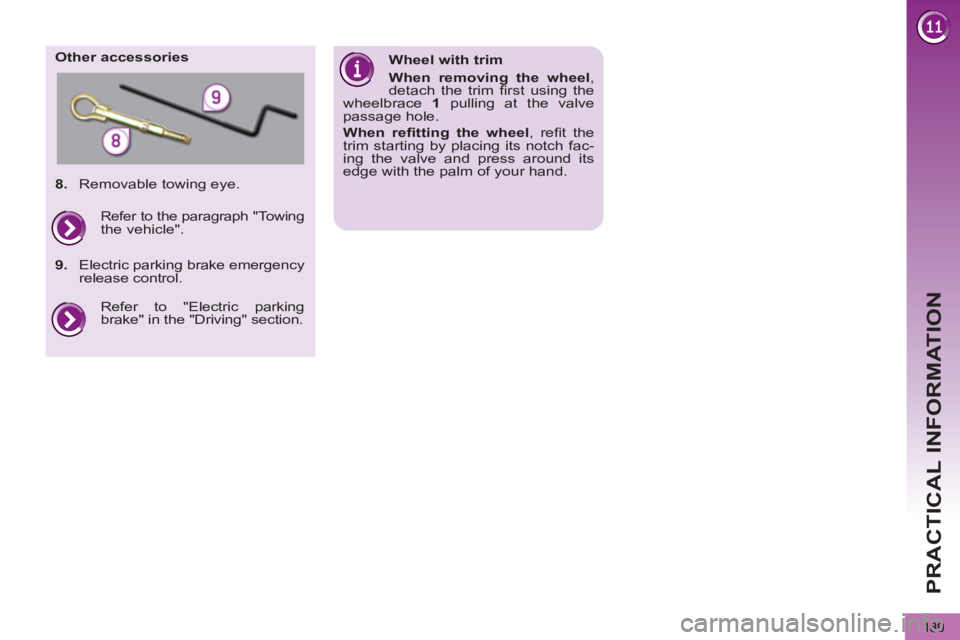
PRACTICAL INFORMATION
189
Other accessories
Wheel with trim
When removing the wheel
,
detach the trim fi rst using the
wheelbrace 1
pulling at the valve
passage hole.
When refi tting the wheel
, refi t the
trim starting by placing its notch fac-
ing the valve and press around its
edge with the palm of your hand.
8.
Removable towing eye.
Refer to "Electric parking
brake" in the "Driving" section.
Refer to the paragraph "Towing
the vehicle".
9.
Electric parking brake emergency
release control.
Page 192 of 340
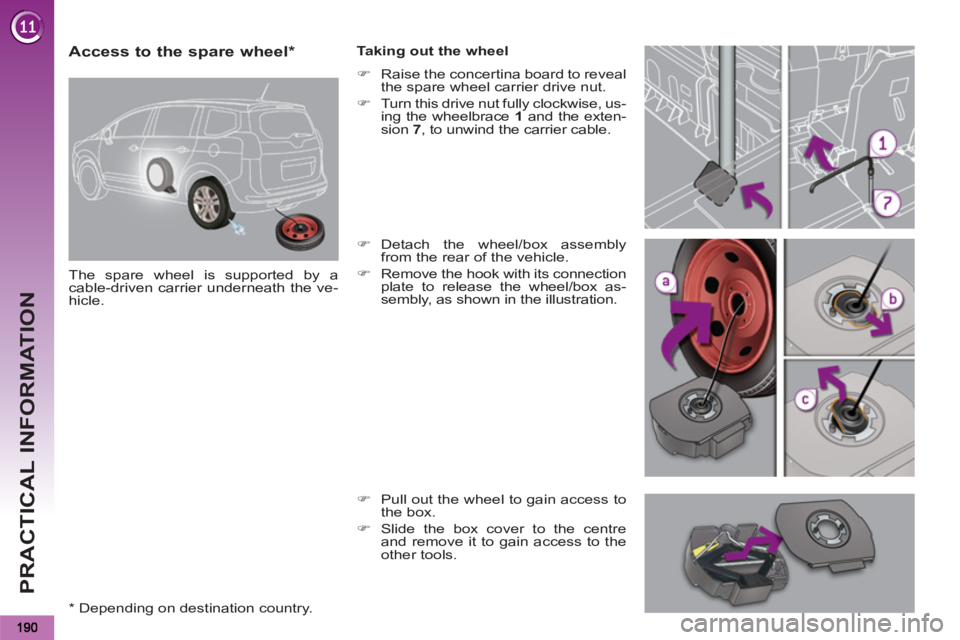
PRACTICAL INFORMATION
Access to the spare wheel *
The spare wheel is supported by a
cable-driven carrier underneath the ve-
hicle.
Taking out the wheel
�)
Raise the concertina board to reveal
the spare wheel carrier drive nut.
�)
Turn this drive nut fully clockwise, us-
ing the wheelbrace 1
and the exten-
sion 7
, to unwind the carrier cable.
�)
Detach the wheel/box assembly
from the rear of the vehicle.
�)
Remove the hook with its connection
plate to release the wheel/box as-
sembly, as shown in the illustration.
�)
Pull out the wheel to gain access to
the box.
�)
Slide the box cover to the centre
and remove it to gain access to the
other tools.
*
Depending on destination country.
Page 193 of 340
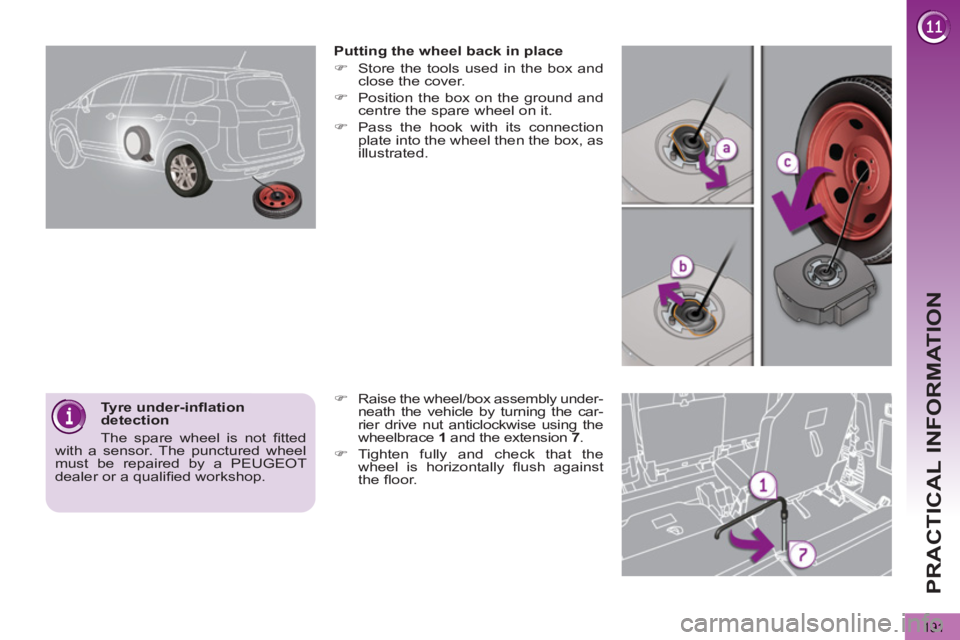
PRACTICAL INFORMATION
191
Tyre under-infl ation
detection
The spare wheel is not fi tted
with a sensor. The punctured wheel
must be repaired by a PEUGEOT
dealer or a qualifi ed workshop.
Putting the wheel back in place
�)
Store the tools used in the box and
close the cover.
�)
Position the box on the ground and
centre the spare wheel on it.
�)
Pass the hook with its connection
plate into the wheel then the box, as
illustrated.
�)
Raise the wheel/box assembly under-
neath the vehicle by turning the car-
rier drive nut anticlockwise using the
wheelbrace 1
and the extension 7
.
�)
Tighten fully and check that the
wheel is horizontally fl ush against
the fl oor.
Page 194 of 340
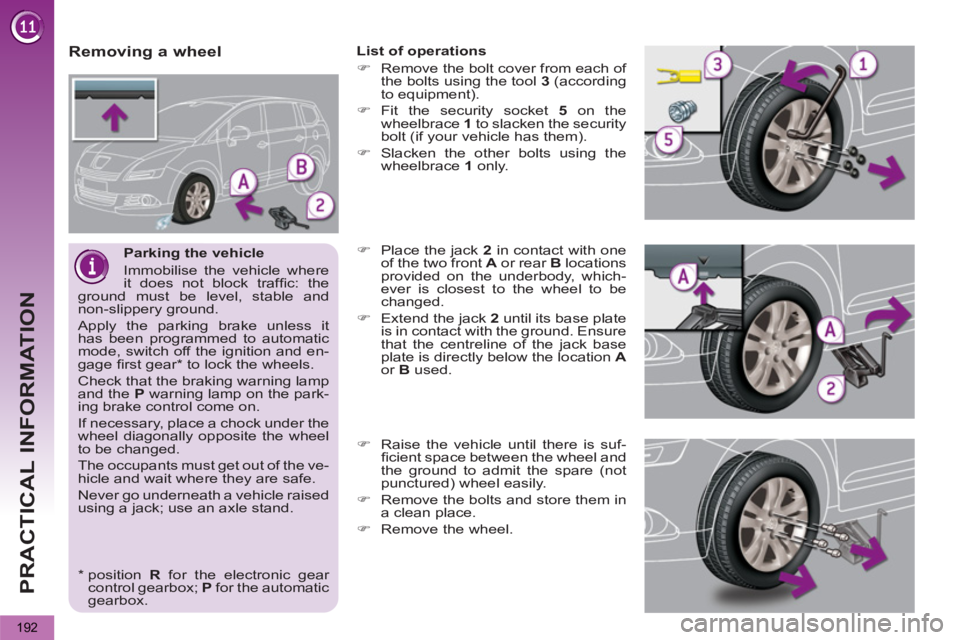
PRACTICAL INFORMATION
192
Parking the vehicle
Immobilise the vehicle where
it does not block traffi c: the
ground must be level, stable and
non-slippery ground.
Apply the parking brake unless it
has been programmed to automatic
mode, switch off the ignition and en-
gage fi rst gear * to lock the wheels.
Check that the braking warning lamp
and the P
warning lamp on the park-
ing brake control come on.
If necessary, place a chock under the
wheel diagonally opposite the wheel
to be changed.
The occupants must get out of the ve-
hicle and wait where they are safe.
Never go underneath a vehicle raised
using a jack; use an axle stand.
Removing a wheel
List of operations
�)
Remove the bolt cover from each of
the bolts using the tool 3
(according
to equipment).
�)
Fit the security socket 5
on the
wheelbrace 1
to slacken the security
bolt (if your vehicle has them).
�)
Slacken the other bolts using the
wheelbrace 1
only.
�)
Place the jack 2
in contact with one
of the two front A
or rear B
locations
provided on the underbody, which-
ever is closest to the wheel to be
changed.
�)
Extend the jack 2
until its base plate
is in contact with the ground. Ensure
that the centreline of the jack base
plate is directly below the location A
or B
used.
�)
Raise the vehicle until there is suf-
fi cient space between the wheel and
the ground to admit the spare (not
punctured) wheel easily.
�)
Remove the bolts and store them in
a clean place.
�)
Remove the wheel.
*
position R
for the electronic gear
control gearbox; P
for the automatic
gearbox.
Page 195 of 340
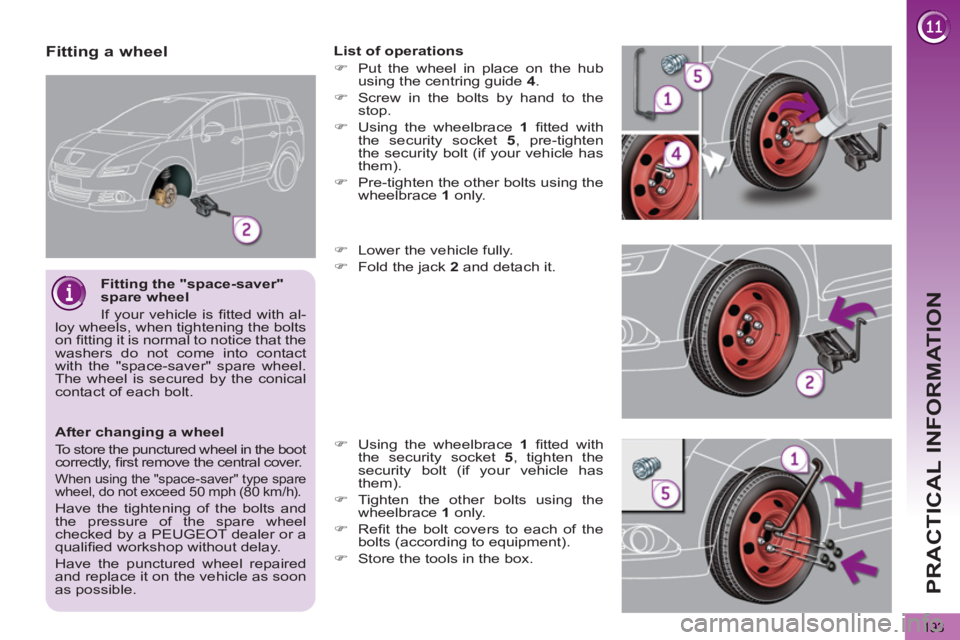
PRACTICAL INFORMATION
193
After changing a wheel
To store the punctured wheel in the boot
correctly, fi rst remove the central cover.
When using the "space-saver" type spare wheel, do not exceed 50 mph (80 km/h).
Have the tightening of the bolts and
the pressure of the spare wheel
checked by a PEUGEOT dealer or a
qualifi ed workshop without delay.
Have the punctured wheel repaired
and replace it on the vehicle as soon
as possible.
Fitting a wheel
List of operations
�)
Put the wheel in place on the hub
using the centring guide 4
.
�)
Screw in the bolts by hand to the
stop.
�)
Using the wheelbrace 1
fi tted with
the security socket 5
, pre-tighten
the security bolt (if your vehicle has
them).
�)
Pre-tighten the other bolts using the
wheelbrace 1
only.
�)
Lower the vehicle fully.
�)
Fold the jack 2
and detach it.
�)
Using the wheelbrace 1
fi tted with
the security socket 5
, tighten the
security bolt (if your vehicle has
them).
�)
Tighten the other bolts using the
wheelbrace 1
only.
�)
Refi t the bolt covers to each of the
bolts (according to equipment).
�)
Store the tools in the box.
Fitting the "space-saver"
spare wheel
If your vehicle is fi tted with al-
loy wheels, when tightening the bolts
on fi tting it is normal to notice that the
washers do not come into contact
with the "space-saver" spare wheel.
The wheel is secured by the conical
contact of each bolt.
Page 196 of 340
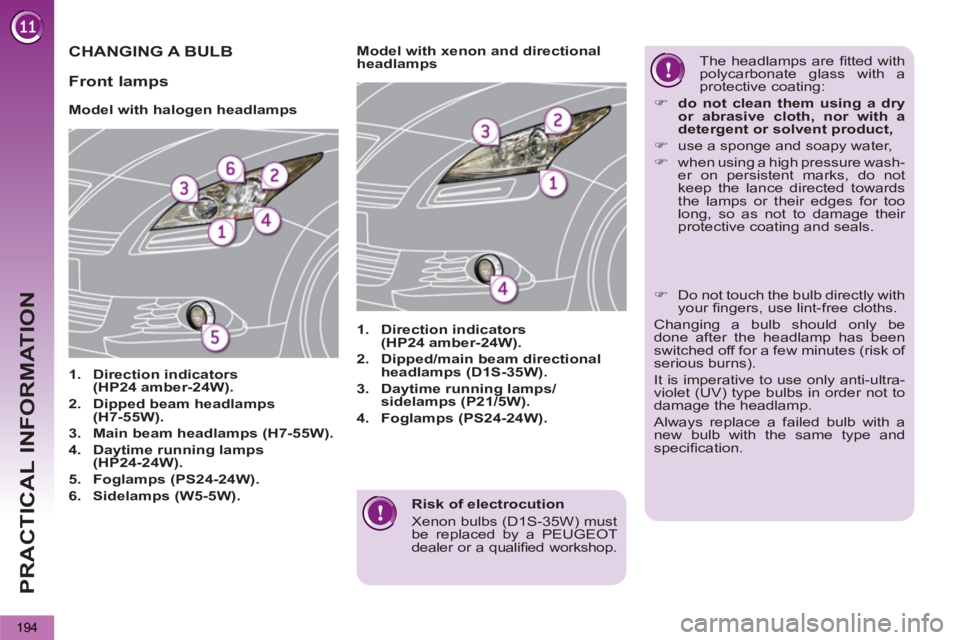
PRACTICAL INFORMATION
194
Risk of electrocution
Xenon bulbs (D1S-35W) must
be replaced by a PEUGEOT
dealer or a qualifi ed workshop.
CHANGING A BULB
Model with halogen headlamps
1.
Direction indicators
(HP24 amber-24W).
2.
Dipped beam headlamps
(H7-55W).
3.
Main beam headlamps (H7-55W).
4.
Daytime running lamps
(HP24-24W).
5.
Foglamps (PS24-24W).
6.
Sidelamps (W5-5W).
1.
Direction indicators
(HP24 amber-24W).
2.
Dipped/main beam directional
headlamps (D1S-35W).
3.
Daytime running lamps/
sidelamps (P21/5W).
4.
Foglamps (PS24-24W).
Model with xenon and directional
headlamps The headlamps are fi tted with
polycarbonate glass with a
protective coating:
�)
do not clean them using a dry
or abrasive cloth, nor with a
detergent or solvent product,
�)
use a sponge and soapy water,
�)
when using a high pressure wash-
er on persistent marks, do not
keep the lance directed towards
the lamps or their edges for too
long, so as not to damage their
protective coating and seals.
Front lamps
�)
Do not touch the bulb directly with
your fi ngers, use lint-free cloths.
Changing a bulb should only be
done after the headlamp has been
switched off for a few minutes (risk of
serious burns).
It is imperative to use only anti-ultra-
violet (UV) type bulbs in order not to
damage the headlamp.
Always replace a failed bulb with a
new bulb with the same type and
specifi cation.
Page 197 of 340

PRACTICAL INFORMATION
195
Changing main beam headlamp and
sidelamp bulbs
Changing dipped beam headlamp bulbs
(models with halogen headlamps)
�)
Remove the protective plastic cover
by pulling on the tab.
�)
Disconnect the bulb connector.
�)
Extract the bulb by pulling and
change it.
To r efi t, carry out these operations in re-
verse order.
�)
Remove the protective plastic cover
by pulling on the tab.
�)
Disconnect the bulb connector.
�)
Remove the bulb by pulling and
change it.
To r efi t, carry out these operations in re-
verse order.
Changing direction indicator and
daytime running lamp bulbs (models
with halogen headlamps)
Contact a PEUGEOT dealer or a quali-
fi ed workshop.
Page 198 of 340
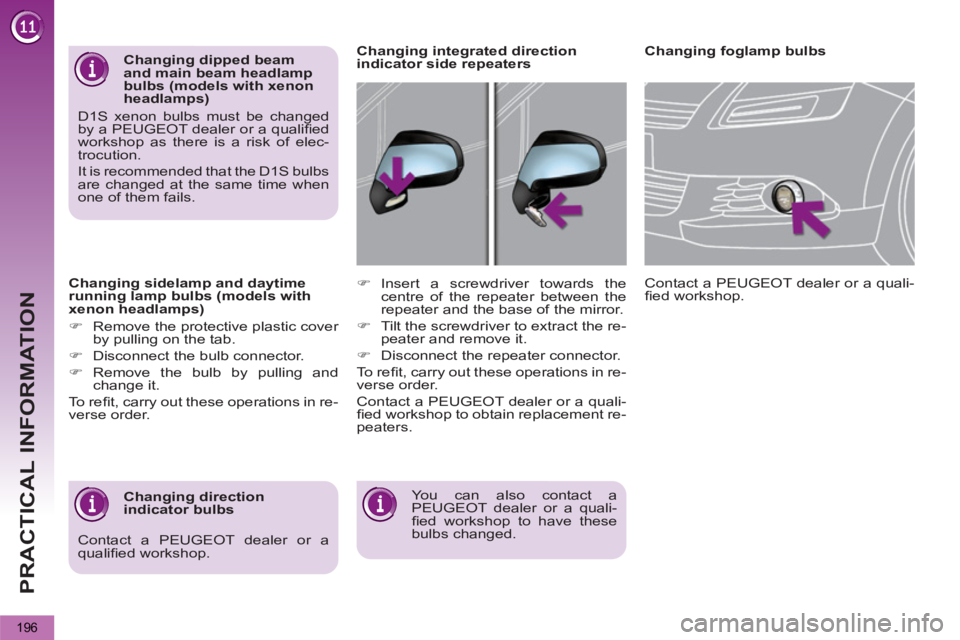
PRACTICAL INFORMATION
196
Changing sidelamp and daytime
running lamp bulbs (models with
xenon headlamps)
�)
Remove the protective plastic cover
by pulling on the tab.
�)
Disconnect the bulb connector.
�)
Remove the bulb by pulling and
change it.
To r efi t, carry out these operations in re-
verse order.
Changing foglamp bulbs
You can also contact a
PEUGEOT dealer or a quali-
fi ed workshop to have these
bulbs changed.
Contact a PEUGEOT dealer or a quali-
fi ed workshop.
�)
Insert a screwdriver towards the
centre of the repeater between the
repeater and the base of the mirror.
�)
Tilt the screwdriver to extract the re-
peater and remove it.
�)
Disconnect the repeater connector.
To r efi t, carry out these operations in re-
verse order.
Contact a PEUGEOT dealer or a quali-
fi ed workshop to obtain replacement re-
peaters.
Changing integrated direction
indicator side repeaters
Changing direction
indicator bulbs
Changing dipped beam
and main beam headlamp
bulbs (models with xenon
headlamps)
D1S xenon bulbs must be changed
by a PEUGEOT dealer or a qualifi ed
workshop as there is a risk of elec-
trocution.
It is recommended that the D1S bulbs
are changed at the same time when
one of them fails.
Contact a PEUGEOT dealer or a
qualifi ed workshop.
Page 199 of 340
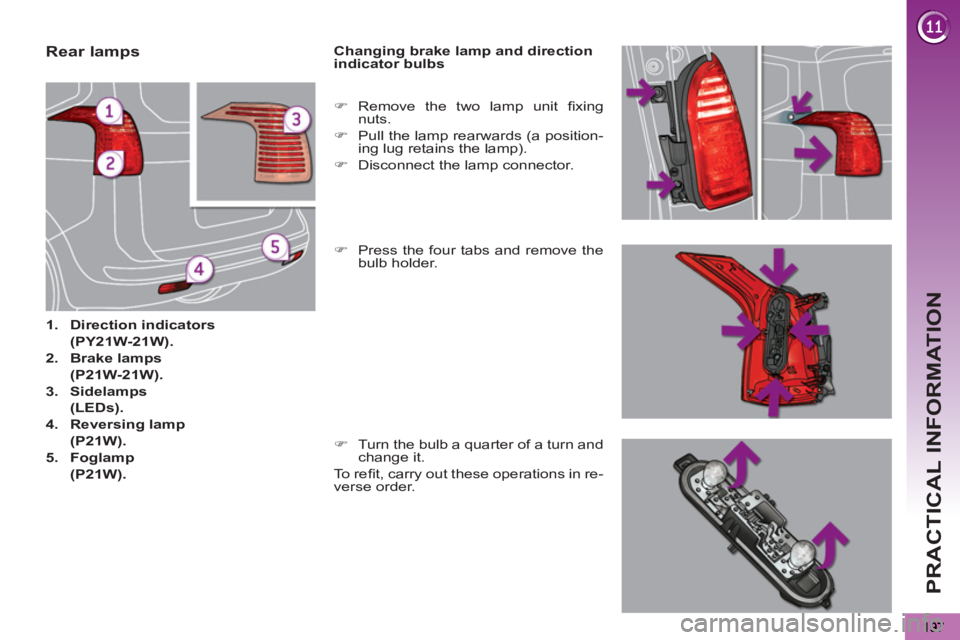
PRACTICAL INFORMATION
Rear lamps
1.
Direction indicators
(PY21W-21W).
2.
Brake lamps
(P21W-21W).
3.
Sidelamps
(LEDs).
4.
Reversing lamp
(P21W).
5.
Foglamp
(P21W).
Changing brake lamp and direction
indicator bulbs
�)
Press the four tabs and remove the
bulb holder.
�)
Remove the two lamp unit fi xing
nuts.
�)
Pull the lamp rearwards (a position-
ing lug retains the lamp).
�)
Disconnect the lamp connector.
�)
Turn the bulb a quarter of a turn and
change it.
To r efi t, carry out these operations in re-
verse order.
Page 200 of 340
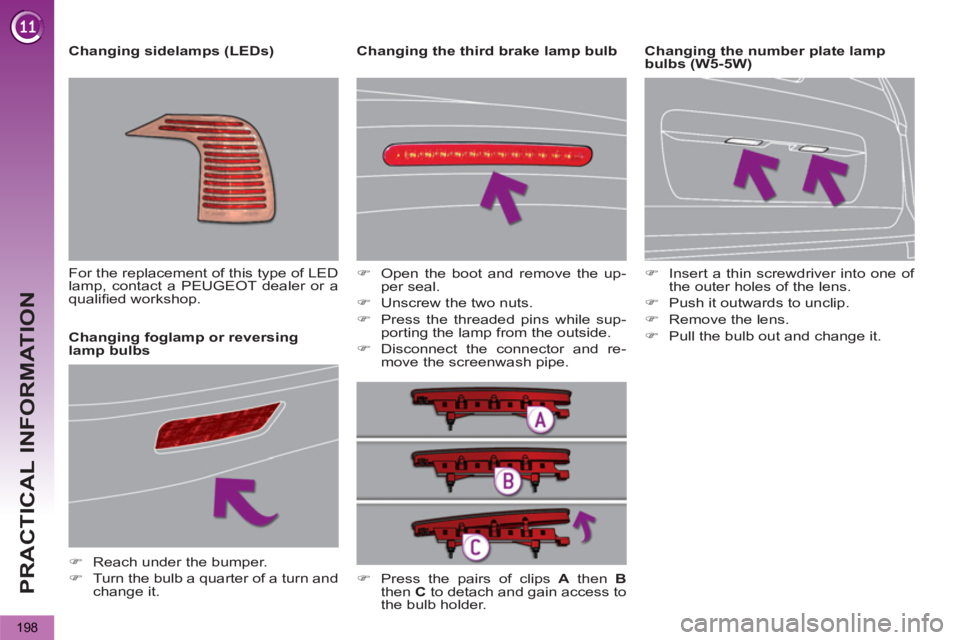
PRACTICAL INFORMATION
198
Changing the third brake lamp bulb
Changing foglamp or reversing
lamp bulbs
�)
Reach under the bumper.
�)
Turn the bulb a quarter of a turn and
change it.
�)
Open the boot and remove the up-
per seal.
�)
Unscrew the two nuts.
�)
Press the threaded pins while sup-
porting the lamp from the outside.
�)
Disconnect the connector and re-
move the screenwash pipe.
�)
Press the pairs of clips A
then B
then C
to detach and gain access to
the bulb holder.
Changing sidelamps (LEDs)
For the replacement of this type of LED
lamp, contact a PEUGEOT dealer or a
qualifi ed workshop.
�)
Insert a thin screwdriver into one of
the outer holes of the lens.
�)
Push it outwards to unclip.
�)
Remove the lens.
�)
Pull the bulb out and change it.
Changing the number plate lamp
bulbs (W5-5W)